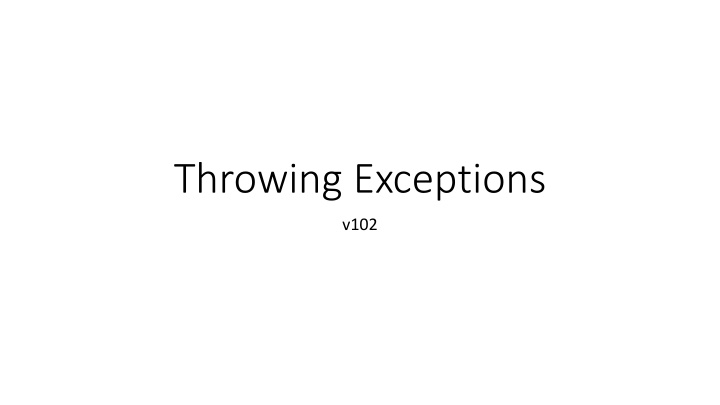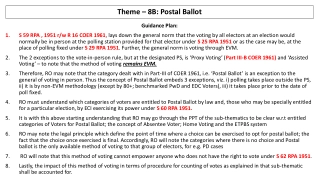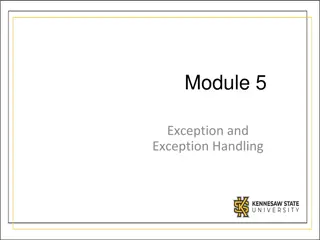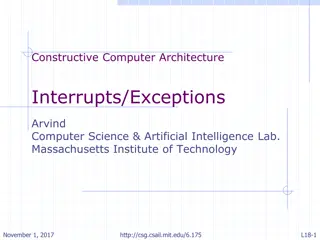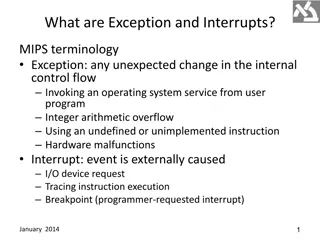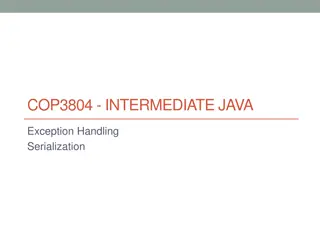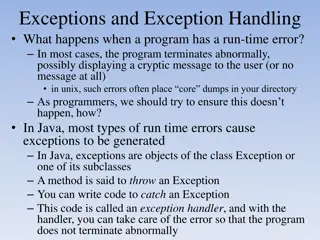Throwing Exceptions
In Java programming, it's essential to handle exceptions effectively. This code example demonstrates the importance of proper error handling by throwing exceptions when invalid data is entered. It shows how to notify users about errors in a graphical program rather than relying on the terminal window. By utilizing exceptions, developers can enhance the user experience and make troubleshooting easier. Learn how to throw and catch exceptions to ensure robust and user-friendly applications.
Download Presentation

Please find below an Image/Link to download the presentation.
The content on the website is provided AS IS for your information and personal use only. It may not be sold, licensed, or shared on other websites without obtaining consent from the author.If you encounter any issues during the download, it is possible that the publisher has removed the file from their server.
You are allowed to download the files provided on this website for personal or commercial use, subject to the condition that they are used lawfully. All files are the property of their respective owners.
The content on the website is provided AS IS for your information and personal use only. It may not be sold, licensed, or shared on other websites without obtaining consent from the author.
E N D
Presentation Transcript
Throwing Exceptions v102
public class Circle extends GeometricObject { public class TestCircle { public static void main(String[] args) { Circle c = new Circle(); Scanner sc = new Scanner(System.in); System.out.print("Enter a radius: "); c.setRadius ( sc.nextInt() ); System.out.println("Radius: " + c.getRadius() ); } } private double radius = 50; public double getRadius() { return radius; } public void setRadius(double radius) { if (radius <= 0) { System.out.println("ERROR! Radius must be > 0."); } else { this.radius = radius; } }
public class TestCircle { public static void main(String[] args) { Circle c = new Circle(); Scanner sc = new Scanner(System.in); System.out.print("Enter a radius: "); c.setRadius ( sc.nextInt() ); System.out.println("Radius: " + c.getRadius() ); } } public class Circle extends GeometricObject { private double radius = 50; public double getRadius() { return radius; } public void setRadius(double radius) { if (radius <= 0) { System.out.println("ERROR! Radius must be > 0."); } else { this.radius = radius; } } Problem: if -10 is entered for the radius in the red program, then the ERROR! Radius must be > 0 occurs. But the output is displayed to the Terminal window. The program might be a graphics program and the user isn t looking at the terminal window. BETTER TO LET THE RED PROGRAM display the error to the user in its own selected way.
Better to throw and an exception public class Circle extends GeometricObject { public class TestCircle { public static void main(String[] args) { Circle c = new Circle(); Scanner sc = new Scanner(System.in); System.out.print("Enter a radius: "); c.setRadius ( sc.nextInt() ); System.out.println("Radius: " + c.getRadius() ); } } private double radius = 50; public double getRadius() { return radius; } public void setRadius(double radius) { if (radius <= 0) { IllegalArgumentException e = new IllegalArgumentException(); throw(e); //System.out.println("ERROR! Radius must be > 0."); } else { this.radius = radius; } } Enter a radius: -10 throw(e) acts like a return statement
Better to throw and an exception public class Circle extends GeometricObject { public class TestCircle { public static void main(String[] args) { Circle c = new Circle(); Scanner sc = new Scanner(System.in); System.out.print("Enter a radius: "); c.setRadius ( sc.nextInt() ); System.out.println("Radius: " + c.getRadius() ); } } private double radius = 50; public double getRadius() { return radius; } public void setRadius(double radius) { if (radius <= 0) { IllegalArgumentException e = new IllegalArgumentException(); throw(e); //System.out.println("ERROR! Radius must be > 0."); } else { this.radius = radius; } } Enter a radius: -10 java.lang.IllegalArgumentException at Circle.setRadius(Circle.java:22) at TestCircle.main(TestCircle.java:18)
Sending your own Message with the Exception public class Circle extends GeometricObject { private double radius = 50; public double getRadius() { return radius; } public void setRadius(double radius) { if (radius <= 0) { IllegalArgumentException e = new IllegalArgumentException( The radius must be a positive integer. ); throw(e); //System.out.println("ERROR! Radius must be > 0."); } else { this.radius = radius; } } java.lang.IllegalArgumentException: The radius must be a positive integer. at Circle.setRadius(Circle.java:22) at TestCircle.main(TestCircle.java:18) Enter a radius: -10 }
Sending your own Message with the Exception public class Circle extends GeometricObject { private double radius = 50; public double getRadius() { return radius; } public void setRadius(double radius) { if (radius <= 0) { throw new IllegalArgumentException( The radius must be a positive integer. ); //System.out.println("ERROR! Radius must be > 0."); } else { this.radius = radius; } } java.lang.IllegalArgumentException: The radius must be a positive integer. at Circle.setRadius(Circle.java:22) at TestCircle.main(TestCircle.java:18) Enter a radius: -10 }
public class TestCircle { public static void main(String[] args) { Circle c = new Circle(); Scanner sc = new Scanner(System.in); System.out.print("Enter a radius: "); try { c.setRadius ( sc.nextInt() ); System.out.println("Radius: " + c.getRadius() ); } catch (IllegalArgumentException e) { System.out.println("Radius input error, the radius must be positive."); } } } Enter a radius: -10 Radius input error, the radius must be positive. this line doesn t execute, when radius is negative and processing continues here
Summary Throwing an exception is the RIGHT way of telling the application program that something went wrong. It s the responsibility of the application program to decide whether to CATCH an unchecked exception or to just let it go. public void setRadius(double radius) { if (radius <= 0) { throw new IllegalArgumentException( The radius must be a positive integer. ); } else { this.radius = radius; } } public static void main(String[] args) { Circle c = new Circle(); Scanner sc = new Scanner(System.in); System.out.print("Enter a radius: "); try { c.setRadius ( sc.nextInt() ); System.out.println("Radius: " + c.getRadius() ); } catch (IllegalArgumentException e) { System.out.println("Radius input error, the radius must be positive."); } }
You can make up your own EXCEPTIONS and then throw them. For example, we could make up our own exception. For example, we could throw a BadRadiusException, an unchecked exception which we have made up. 1. Create a new class called, BadRadiusException 2. Extend RuntimeException 3. Add a constructor to it. public void setRadius(double radius) { if (radius <= 0) { throw new BadRadiusException("The radius must be a positive integer."); else { this.radius = radius; } } import java.lang.RuntimeException; Enter a radius: -10 public class BadRadiusException extends RuntimeException { public BadRadiusException(String message) { } } BadRadiusException at Circle.setRadius(Circle.java:22) at TestCircle.main(TestCircle.java:19)
You can make up your own EXCEPTIONS and then throw them. public void setRadius(double radius) { if (radius <= 0) { throw new BadRadiusException("The radius must be a positive integer."); else { this.radius = radius; } } import java.lang.RuntimeException; public class BadRadiusException extends RuntimeException { //instance var private String message; public BadRadiusException(String message) { this.message = message; } public String toString() { return this.getClass().getSimpleName() + ": " + message; } } Enter a radius: -10 BadRadiusException: The radius must be a positive integer. at Circle.setRadius(Circle.java:22) at TestCircle.main(TestCircle.java:19)
QUIZ QUIZ See if you can answer these EXAM style See if you can answer these EXAM style questions about questions about throwing exceptions throwing exceptions
1.Write a single line of code that will throw an IllegalArgumentException containing the message "Nice try". [1]
1.Write a single line of code that will throw an IllegalArgumentException containing the message "Nice try". [1] throw new IllegalArgumentException( Nice try );
2. Write code to call a method named testMethod(). This method might throw an IllegalArgumentException. Include code to catch that exception and print the message contained in that exception to System.out. [4]
2. Write code to call a method named testMethod(). This method might throw an IllegalArgumentException. Include code to catch that exception and print the message contained in that exception to System.out. [4] try { } catch ( IllegalArgumentException e ) { System.out.println( e.getMessage() ); } testMethod();
3. Explain the difference between checked and unchecked exceptions. Give one example of each type of exception. [4]
3. Explain the difference between checked and unchecked exceptions. Give one example of each type of exception. [4] A checked exception must either be caught or be declared to be thrown by adding the throws declaration to the method. InputMismatchException is unchecked; FileNotFoundException is checked.
In summary, checked exceptions are required to be either caught or declared, while unchecked exceptions can be caught optionally, but they do not have to be declared explicitly in the method signature. Unchecked exceptions are often used for cases where the failure is beyond the programmer's control (e.g., division by zero) Checked exceptions are used for conditions that the programmer can anticipate and handle (e.g., file not found).
4. I have a method named badmethod(). It takes no arguments and has no return value but when it s called it might throw a special kind of exception called BadMethodException. Write code that will call badmethodand print ERROR to standard output if it throws the BadMethodException. [5]
4. I have a method named badmethod(). It takes no arguments and has no return value but when it s called it might throw a special kind of exception called BadMethodException. Write code that will call badmethodand print ERROR to standard output if it throws the BadMethodException. [5] try { } catch (BadMethodException e) { System.out.println( ERROR ); } badmethod();
5. Depending on how the user behaves, there are 3 exceptions that might be thrown when this code is run. Your job is to figure out which three exceptions might be thrown then re- write the code with additions to it so that if an exception happens, the program prints a user-friendly message and then starts the program again from the beginning. If the user makes it through with no exceptions, the program should end (i.e. not loop back).[14] public static void main(String[] args) { Scanner sc = new Scanner(System.in); List of Exceptions ArithmethmeticException ArrayIndexOutOfBoundsException FileNotFoundException InputMismatchException InterruptedException NoSuchElementException int[] x = {1,-1,0,2,-2}; int a = sc.nextInt(); int b = sc.nextInt(); int c = x[a]; int d = x[b]; int e = c / d; System.out.println(e); }
5. Depending on how the user behaves, there are 3 exceptions that might be thrown when this code is run. Your job is to figure out which three exceptions might be thrown then re- write the code with additions to it so that if an exception happens, the program prints a user-friendly message and then starts the program again from the beginning. If the user makes it through with no exceptions, the program should end (i.e. not loop back).[14] public static void main(String[] args) { Scanner sc = new Scanner(System.in); boolean not_ok = true; while (not_ok) { try { // content of main method above goes here not_ok = false; } catch (ArithmeticException e) { System.out.println( Can t divide by 0. Start again. ); } catch (InputMismatchException e) { System.out.println( That wasn t an integer. Start again. ); sc.next(); // this is not optional } catch (ArrayIndexOutOfBoundsException e) { System.out.println( Must be in range 0 to 4. Start again. ); } } int[] x = {1,-1,0,2,-2}; int a = sc.nextInt(); int b = sc.nextInt(); int c = x[a]; int d = x[b]; int e = c / d; System.out.println(e); } List of Exceptions ArithmethmeticException ArrayIndexOutOfBoundsException FileNotFoundException InputMismatchException InterruptedException NoSuchElementException
